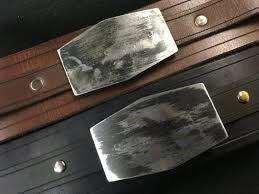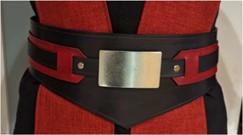Belts
Basic Rules
Belts should be made of leather or hard pleather which gives the appearance of leather, and should be colored to work with the costume and the pouches on the belt.
They need to be firm, and not appear to be wavering while worn or let the edges crinkle.
Belts should have no more than 3 visible holes, or 6 if the holes are in two rows of three or three rows of two.
Jedi may have brown belts, while Sith are allowed black or red.
Metal work on all belts may be silver, antique bronze, copper, gold (bright brass), or gunmetal. All metal work on the belt must match each other.
The belt should rest at the natural waist and should rest straight and parallel the ground. It should not be worn down on the hips or skewed to one side. Belts should be able to support a lightsaber without pulling it down. Please note that many cheap vinyl belts available online are not capable of supporting a saber’s weight, so please check before submitting a costume with one of these. Belts using velcro to secure the rear of the belt closed should be reinforced with snaps or other hidden fasteners to prevent the belt from coming undone during choreography.
Original Trilogy Style Belt
For OT style belts please make sure the width of the belt is at least 2” (5cm) wide. The belt should be made specifically to the applicant’s size or designed to allow the excess part of the strap to be hidden behind the rest of the belt. Buckles on OT style belts should either be Rectangular, Oval, or Octagonal in shape and should be proportional to the width of the belt. No food capsules are needed for original trilogy style belts
Prequel Style Belt
 Two examples of a prequel style belt with a thin and wide belt.
Two examples of a prequel style belt with a thin and wide belt.
Prequel style belts should be roughly 2-3 inches (5-7.5cm) wide, accounting for body type, and have a thinner belt running down the middle of the larger belt.
The inner (narrower) belt should have a buckle or ring serving as a fastener in the middle that appears to be metallic, and secured with two sets of metal studs to the left and right of the fastener.
Studs should be metallic and should be rounded. No spike-like studs are allowed on Prequel style belts.
The inner belt should appear to be continuous, and may have ends secured to the fastener using small leather keepers or metallic rivets or Chicago screws.
Prequel style belts must have a keeper or pouch on the back to cover where the belt is secured so the ends and any fasteners are not visible.
A minimum of four food capsules are needed and no more than twelve is allowed, and they must be in even amounts of four, six, eight, ten or twelve.
The thinner belt may be a different color than the wider belt, as long as all colors are from the primary colors for their faction..
Prequel style belts may also have one or two decorative grooves along each edge of the outer belt.
Inner belts may have one or two decorative grooves along each edge, or one central decorative groove.
These grooves must appear straight, and run parallel to the edge of the belt. All decorative grooves are permitted to be a contrasting color from the rest of the belt, provided that color is in the primary or secondary colors for their faction. No other decorative tooling is permitted.
Combo Style Belt
 Combo style belt example
Combo style belt example
Combo belts are allowed that combines a PT style belt with an OT style belt buckle. This is a 3 inch (7.5cm) wide belt that has an OT style buckle in the middle. The edges of the buckle should be at least 3/4ths the size of the larger belt. Luke Skywalker’s Belt from The Force Awakens is an example of this design, and is allowed for both Jedi and Sith in appropriate colors.
The same rules for contrasting inner belts, decorative grooving, and other tooling laid out for prequel style belts also apply to combo belts.
Imperial Knight Belts
Imperial Knight Belts are permitted for both Sith and Jedi, and follow the standard color and material rules for Jedi and Sith belts.
These belts are three layers.
- The widest layer lays closest to the skin and goes all the way around the body. It may be either one continuous width or have a point on the bottom. The width of this layer should be proportionate to the applicant.
- The middle layer is one continuous width, narrower than the first layer, and ends in shallow points on either side of the buckle. There should be a notable gap between pointed ends of the middle layers and the buckle.
- The final layer is about one inch (2.5cm) wide, goes all the way around the body, and weaves through slots in the middle layer on either side of the buckle.
- It may be riveted to the middle layer
- A keeper is used in the back.
The buckle is unadorned metal, rectangular in shape, and is roughly the same width as the middle layer.
Imperial greeblies are not allowed for Imperial Knight style belts for costumes that fall under the addendum. The Dark Side Military/Inquisitor template allows for the use of Imperial greeblies.
Food capsules are not required for Imperial Knight style belts
Please note that, when worn, no belt ends should be visible on the widest or narrowest layers (all ends for these belts should be hidden under the keeper or buckle).
Maul Belts
This belt style is only permitted for Sith.
It consists of a wide base belt, which has a wider rounded section at the front of the torso, and four narrow belts that sit on top of the wide belt. The narrow belts are riveted to the wide belt, and no visible buckles are used. A keeper at the middle back hides the ends of all the belts and makes them appear continuous.




